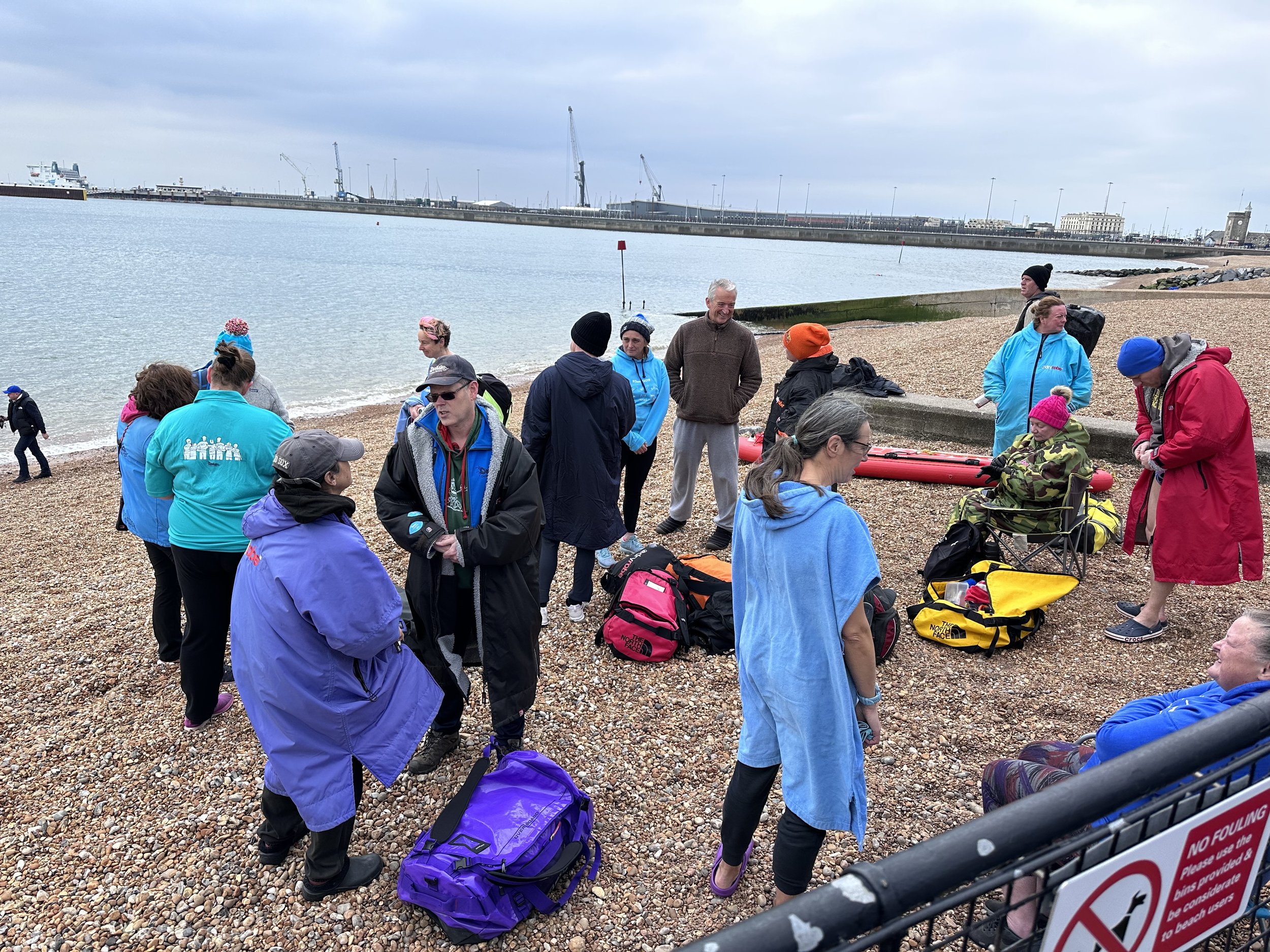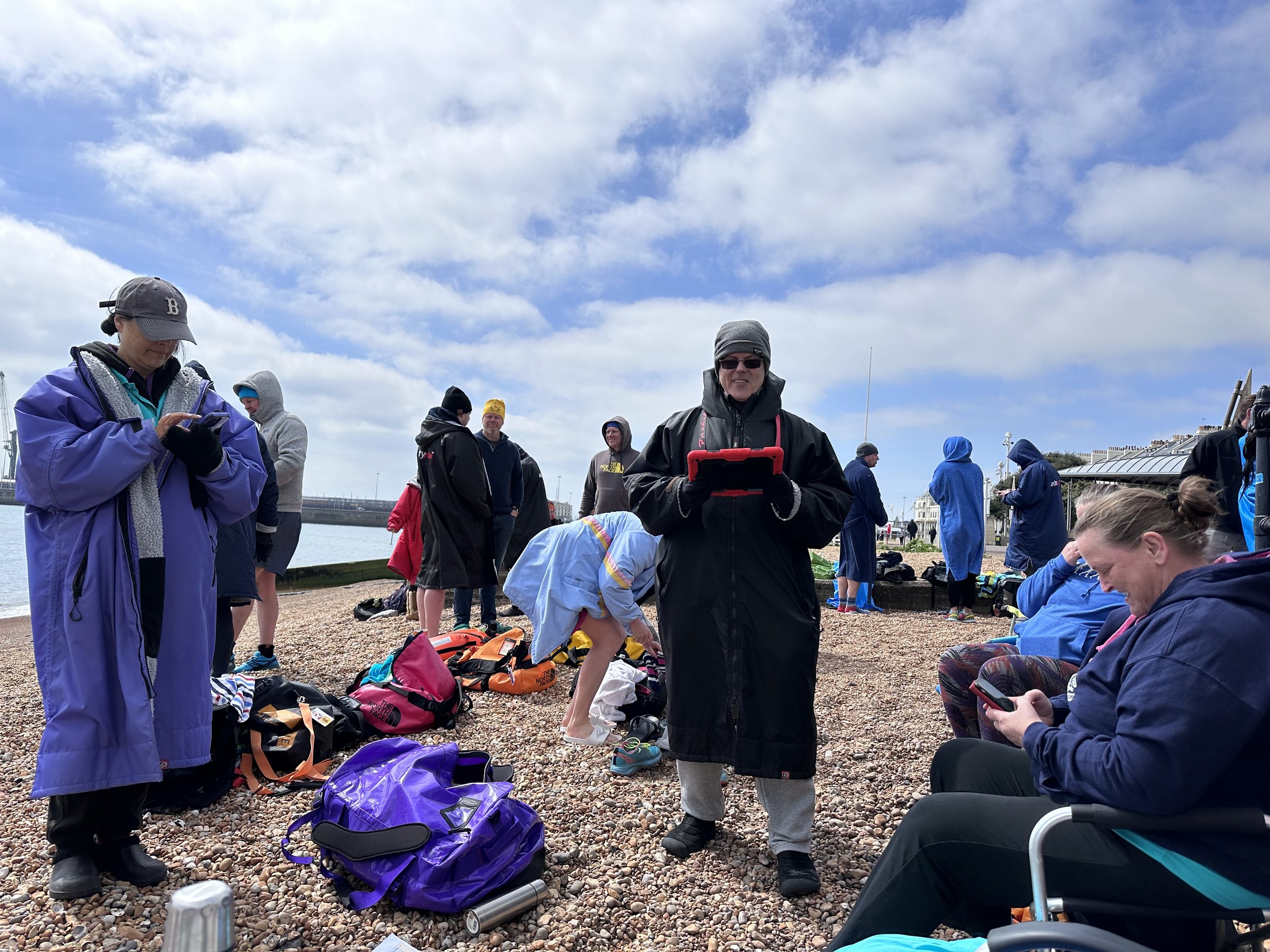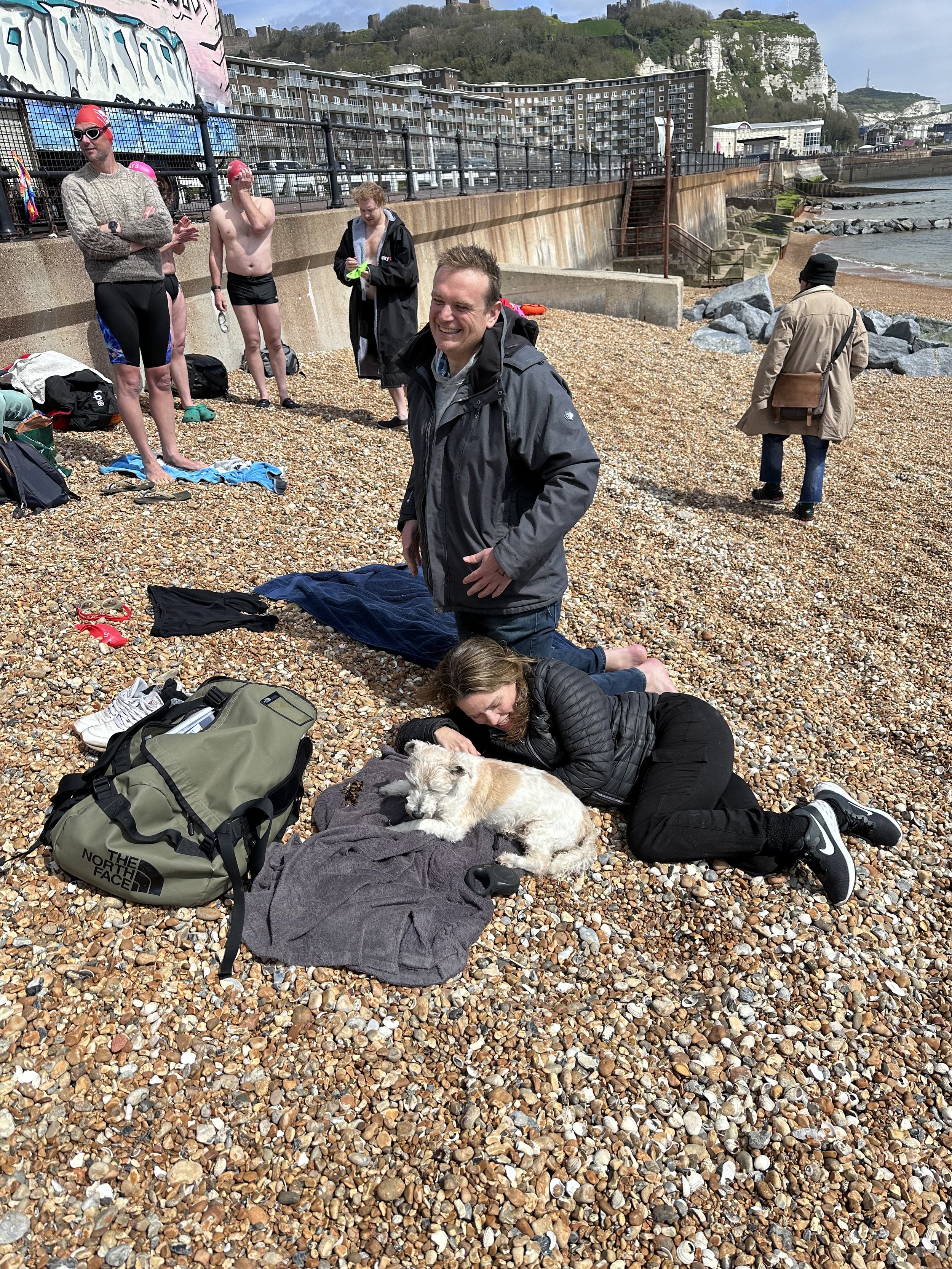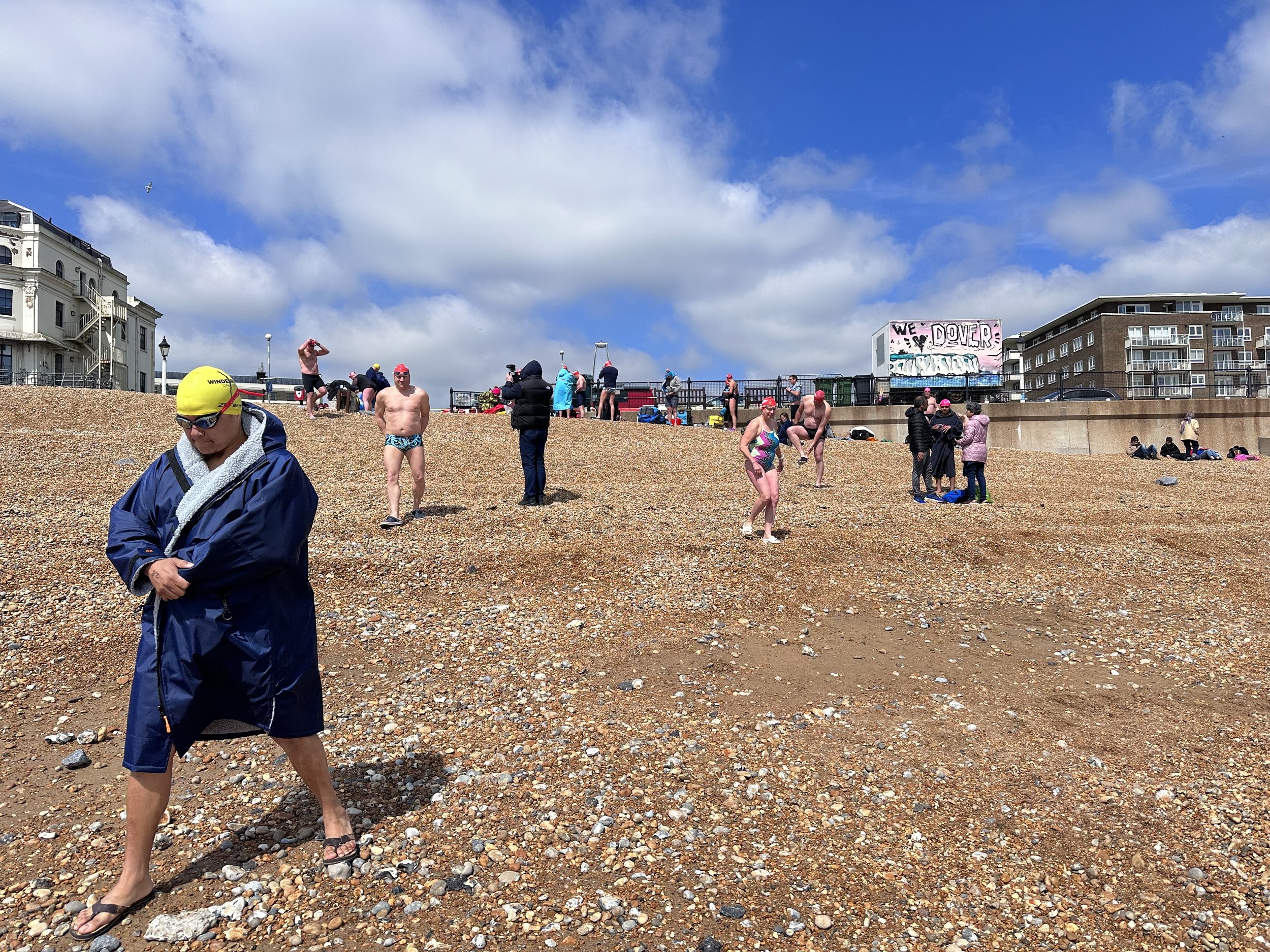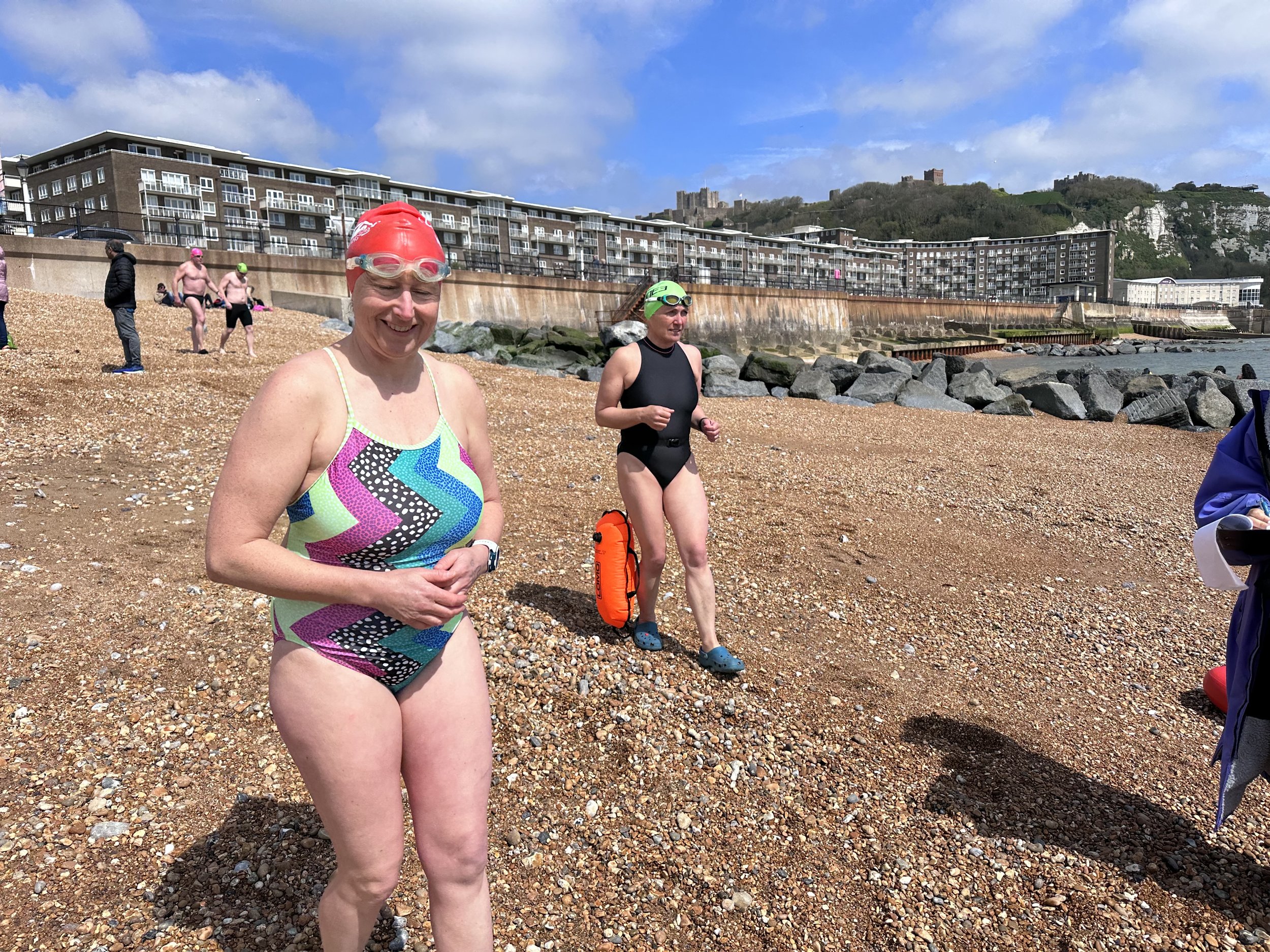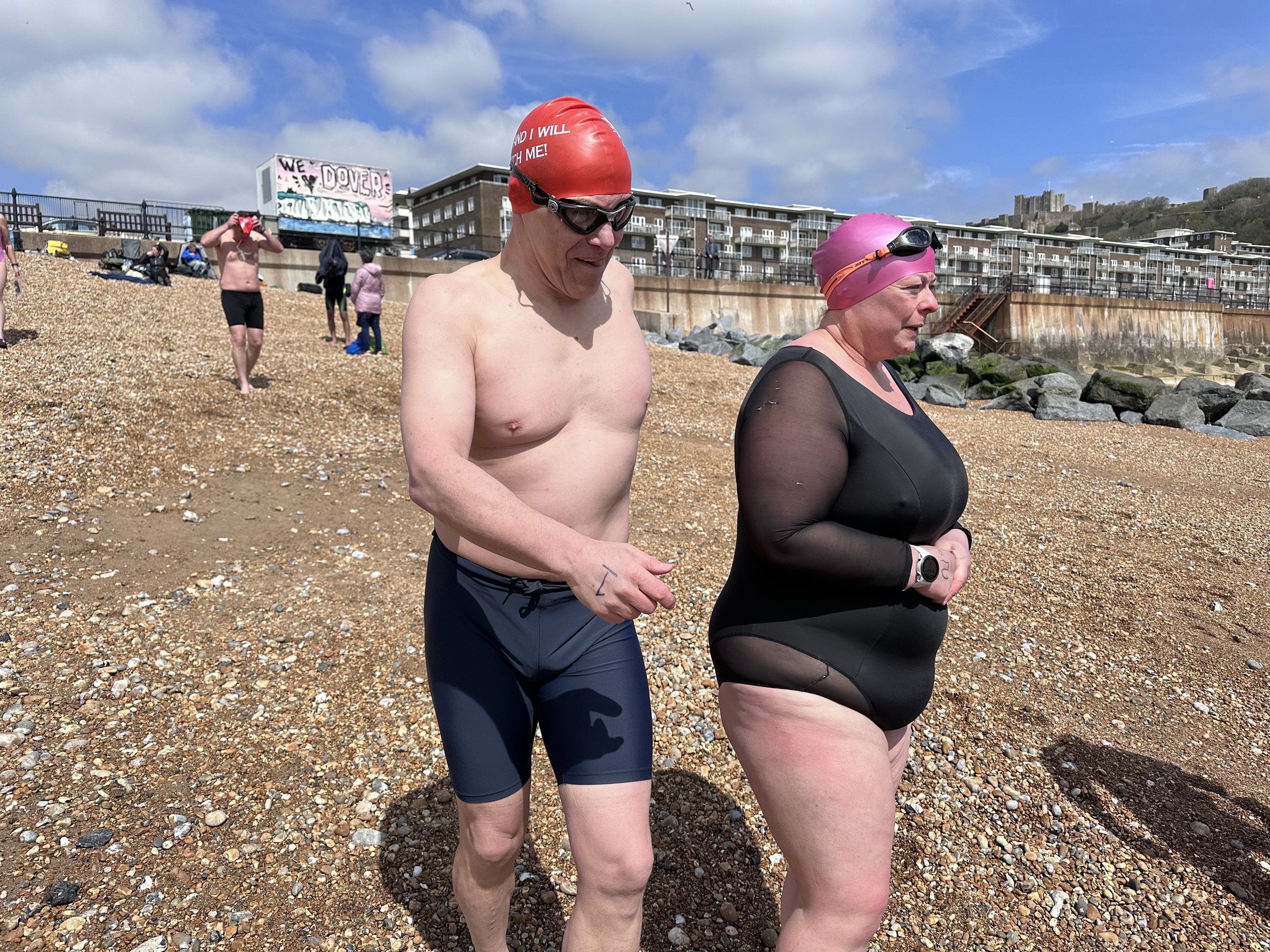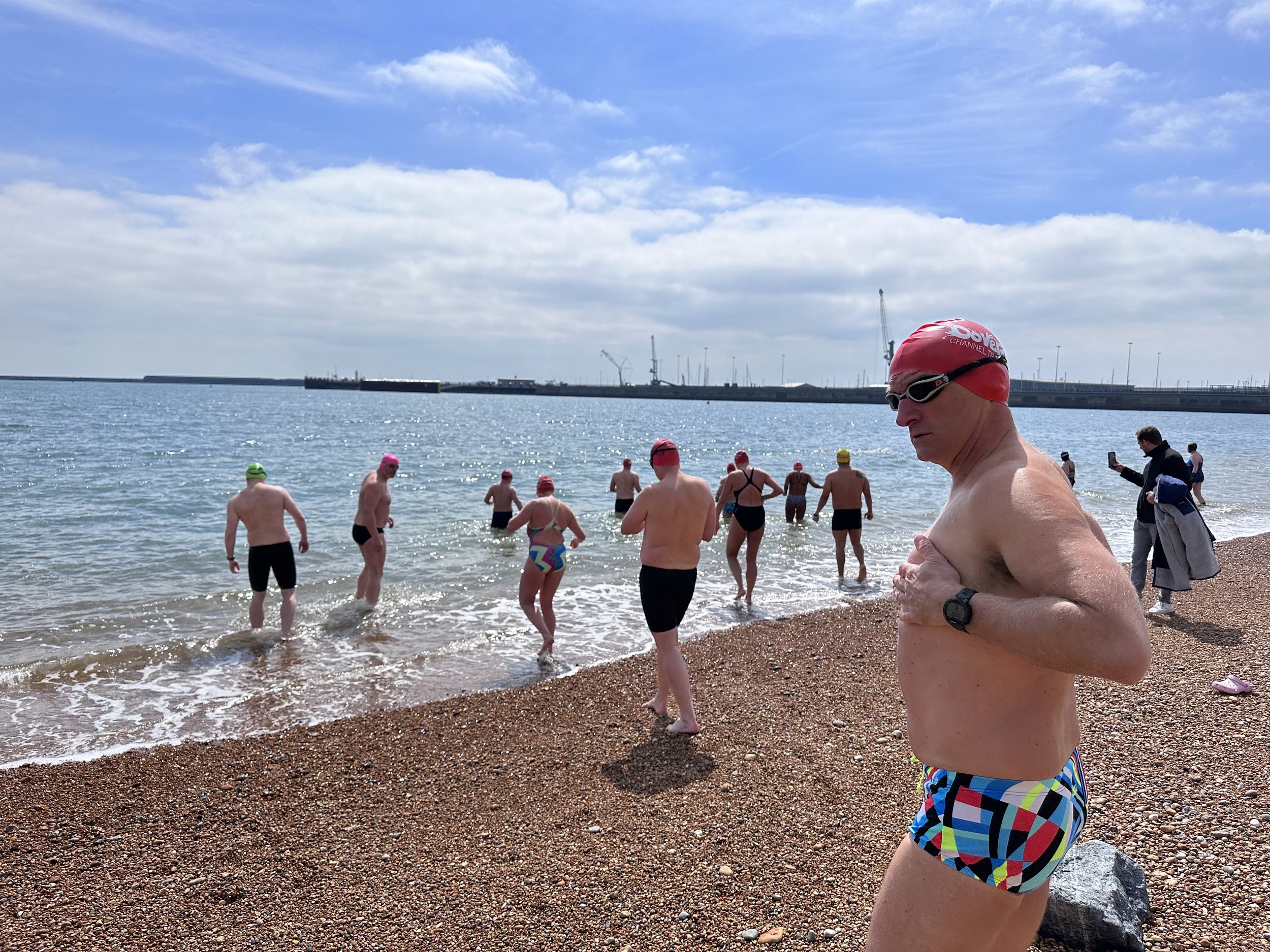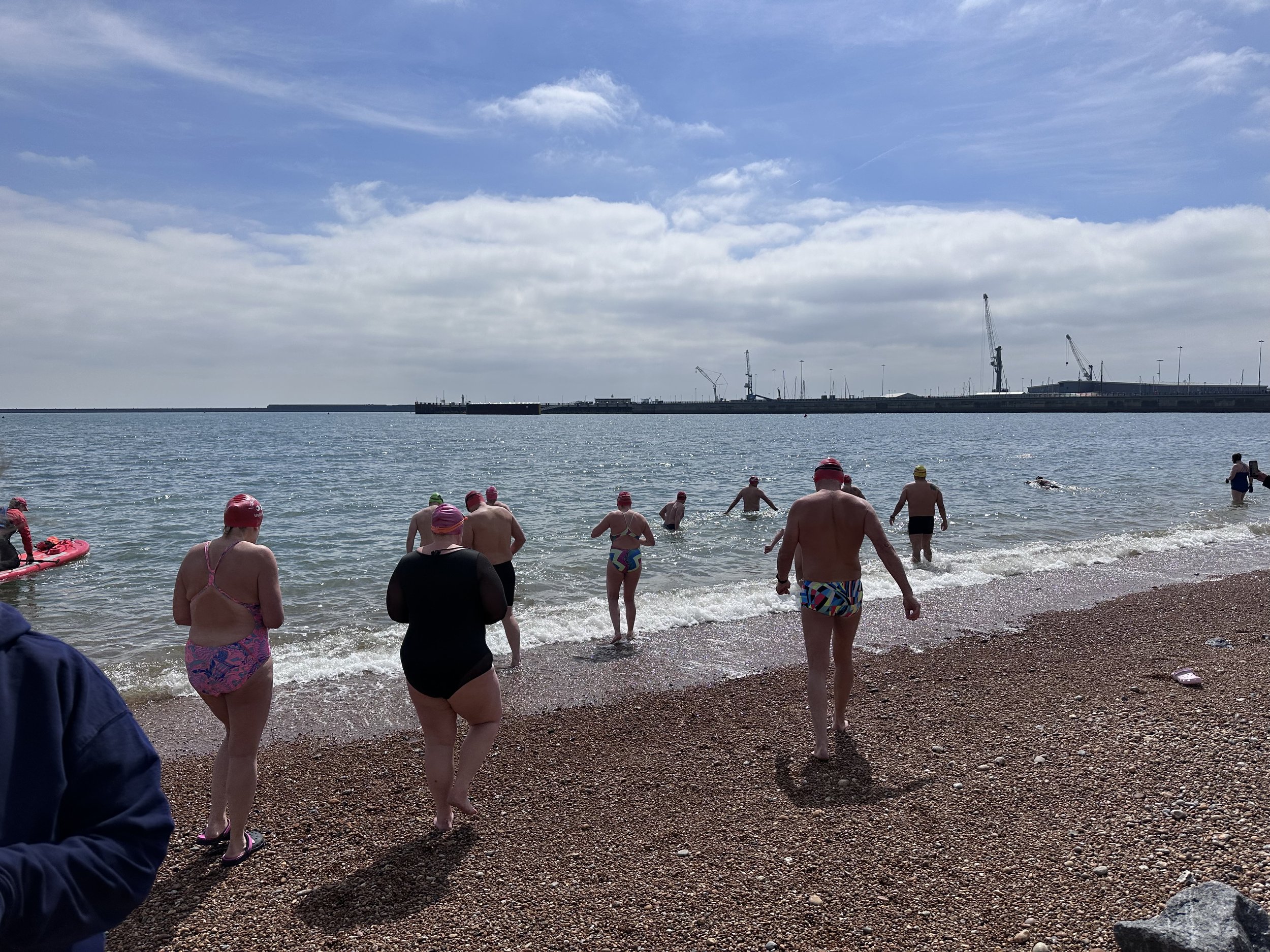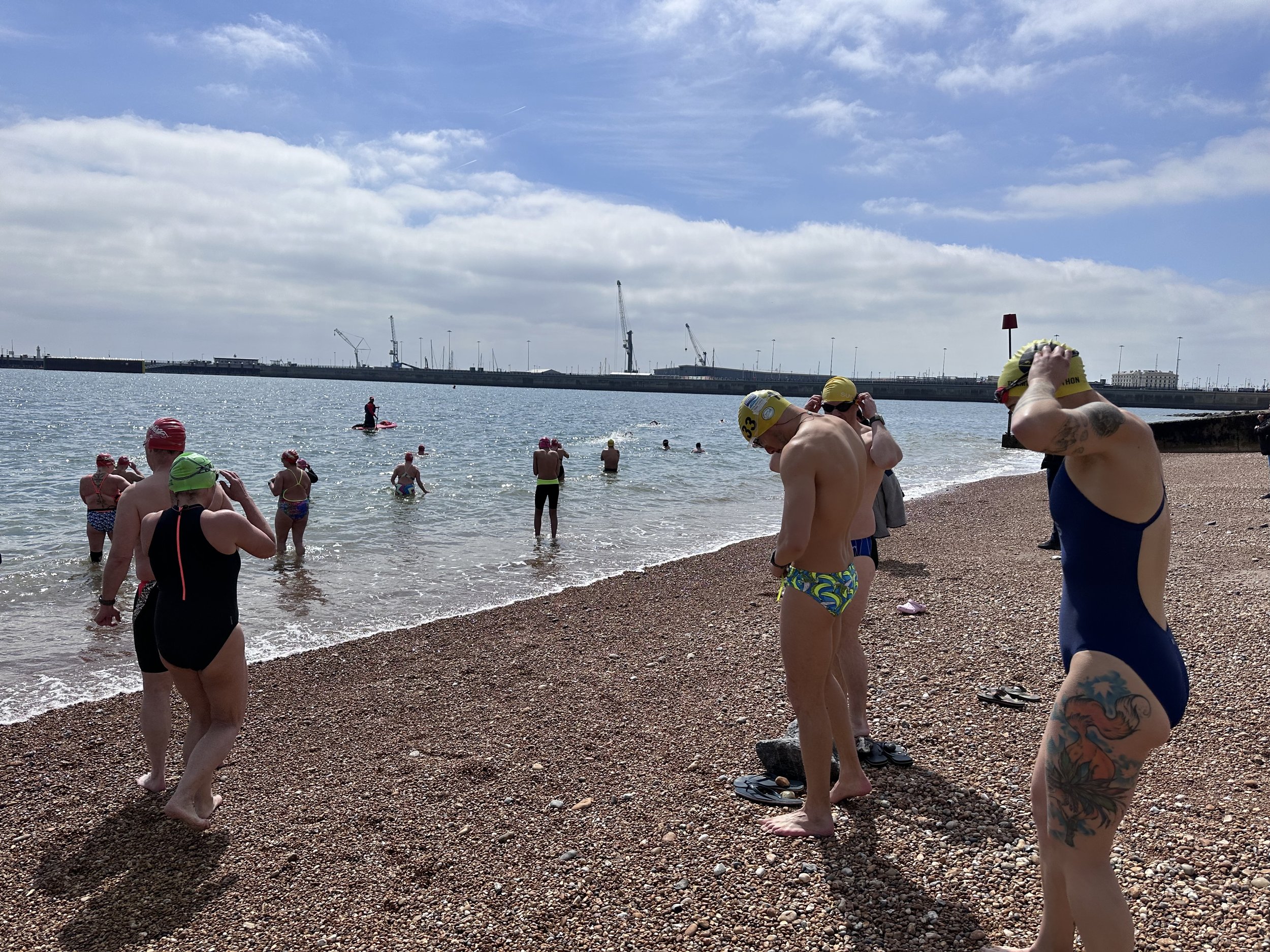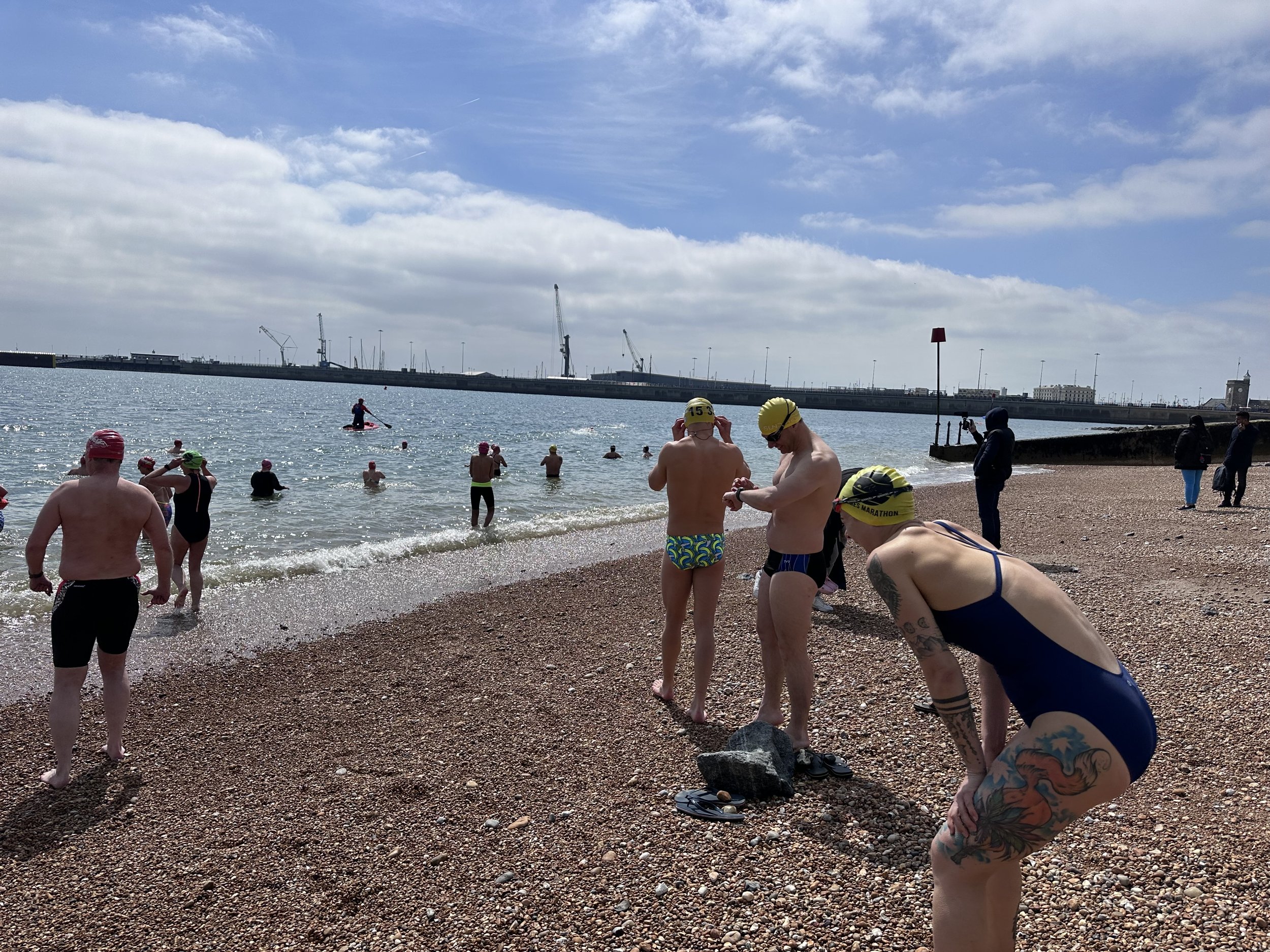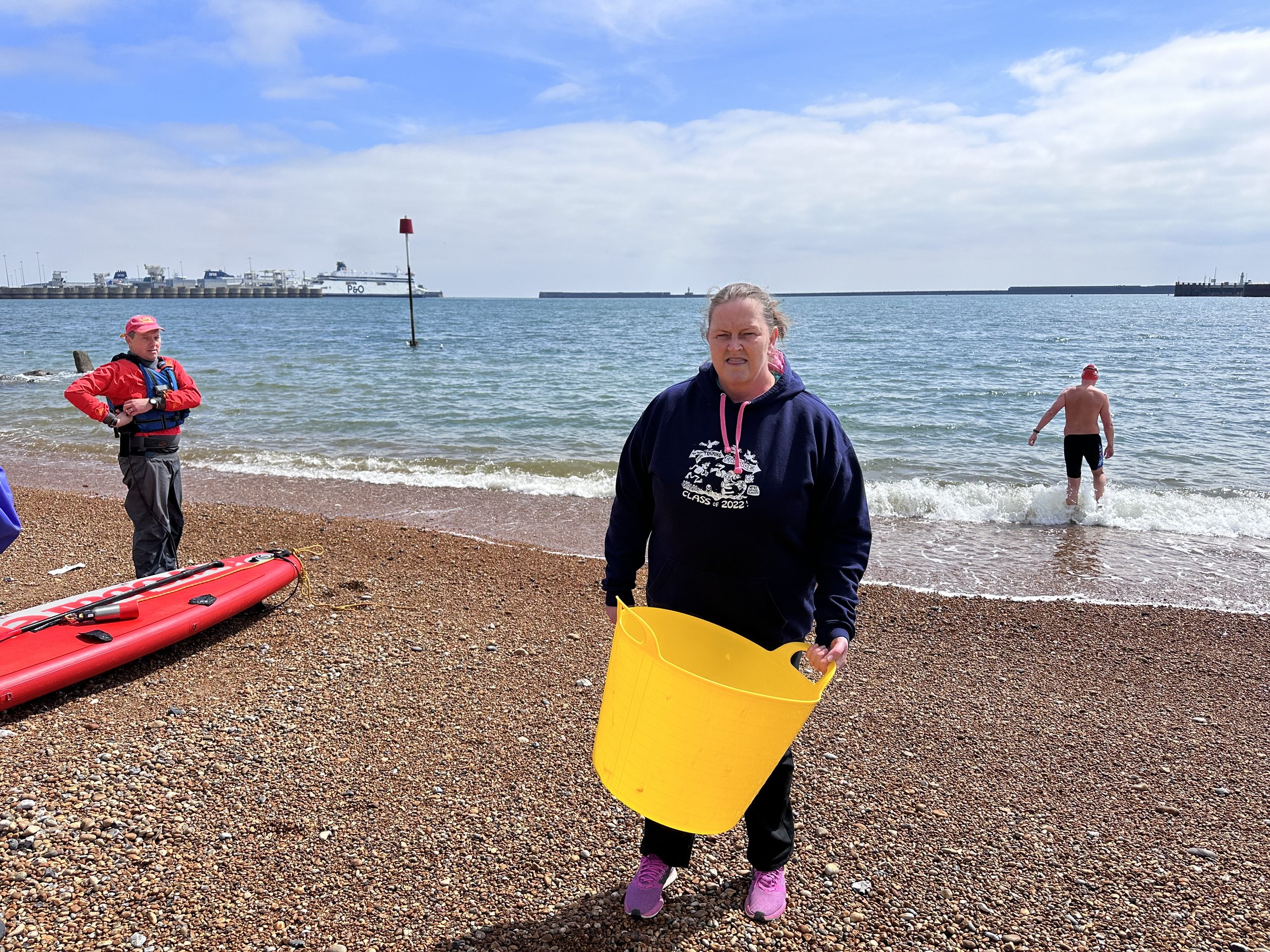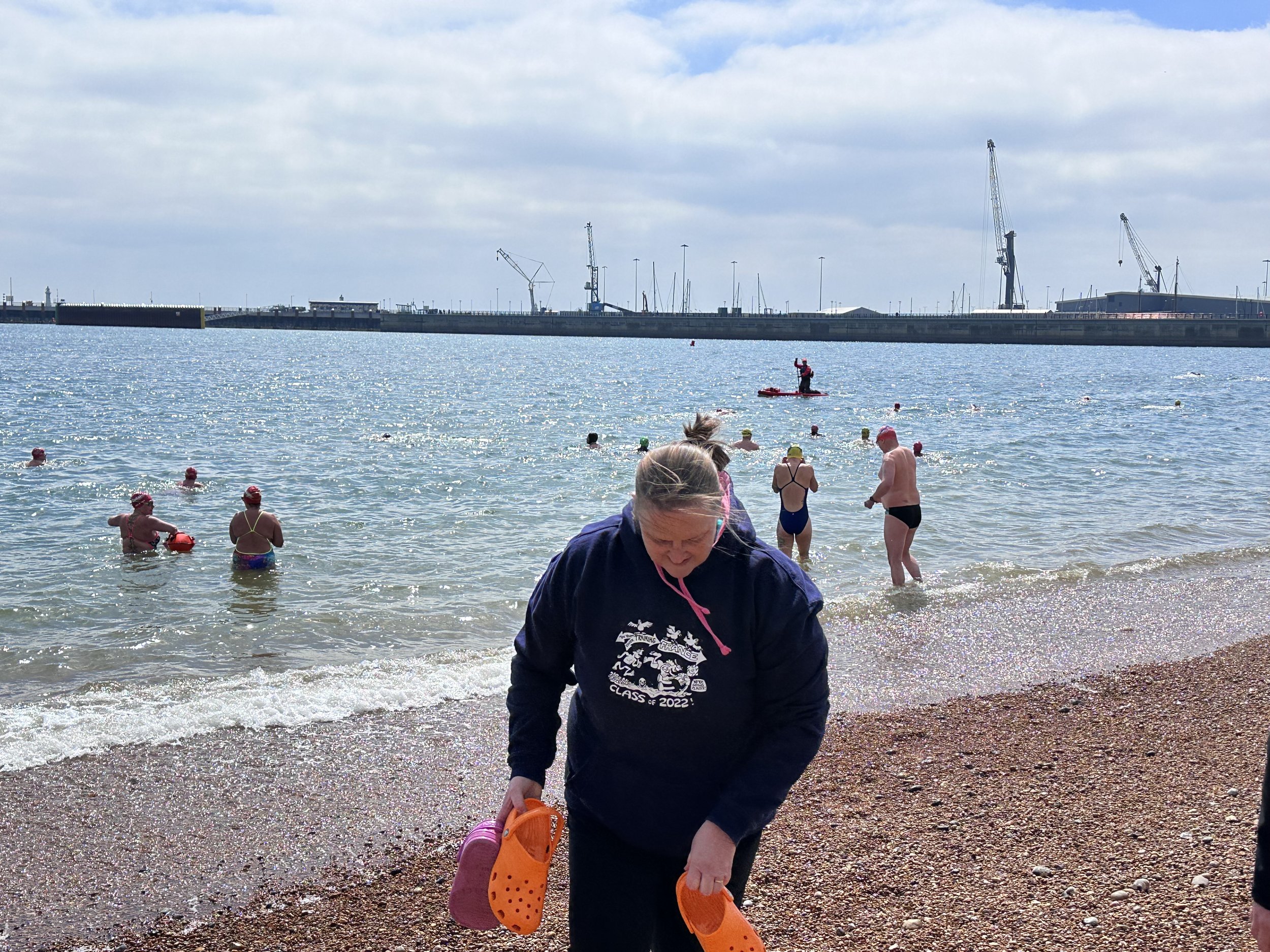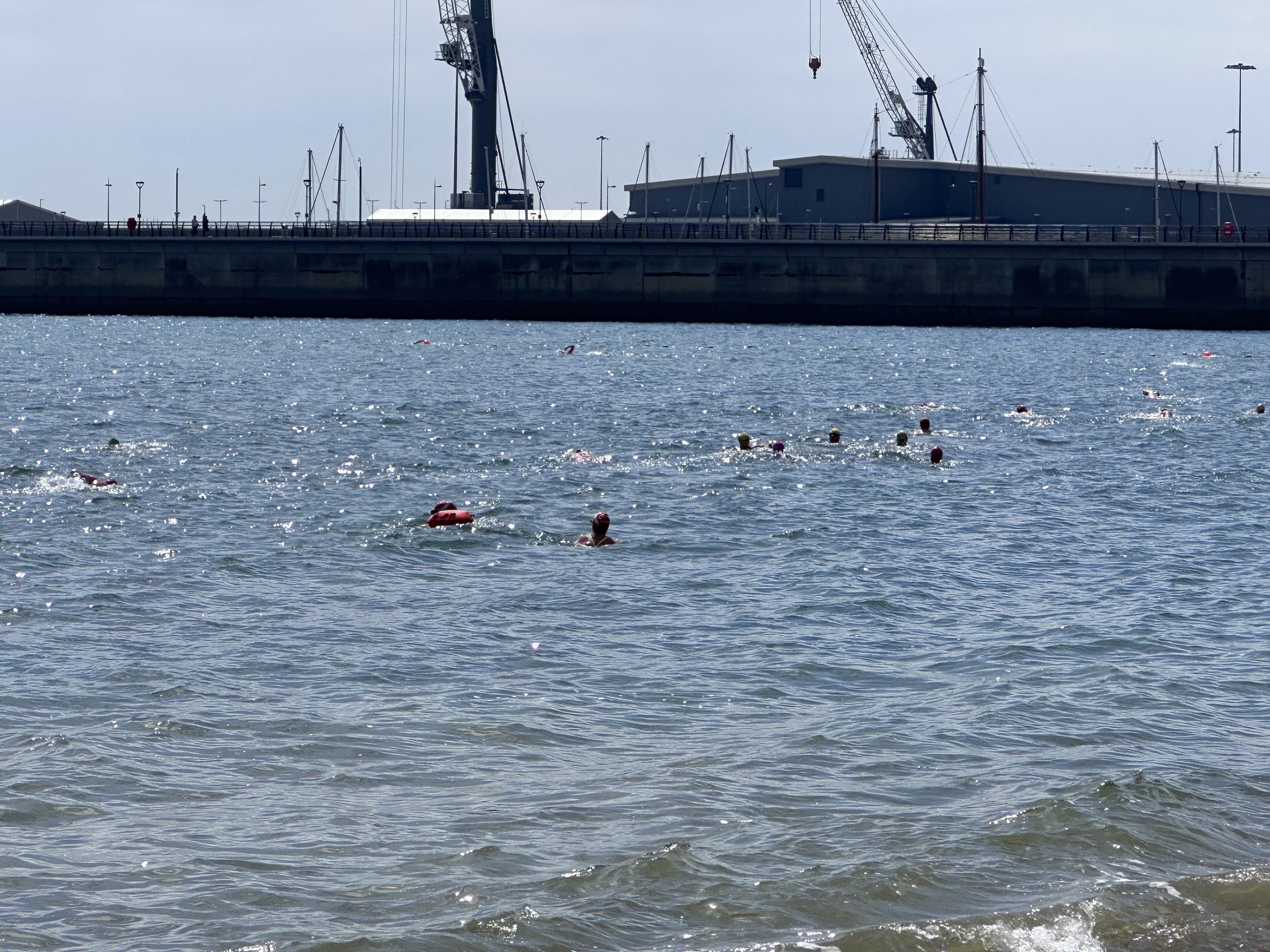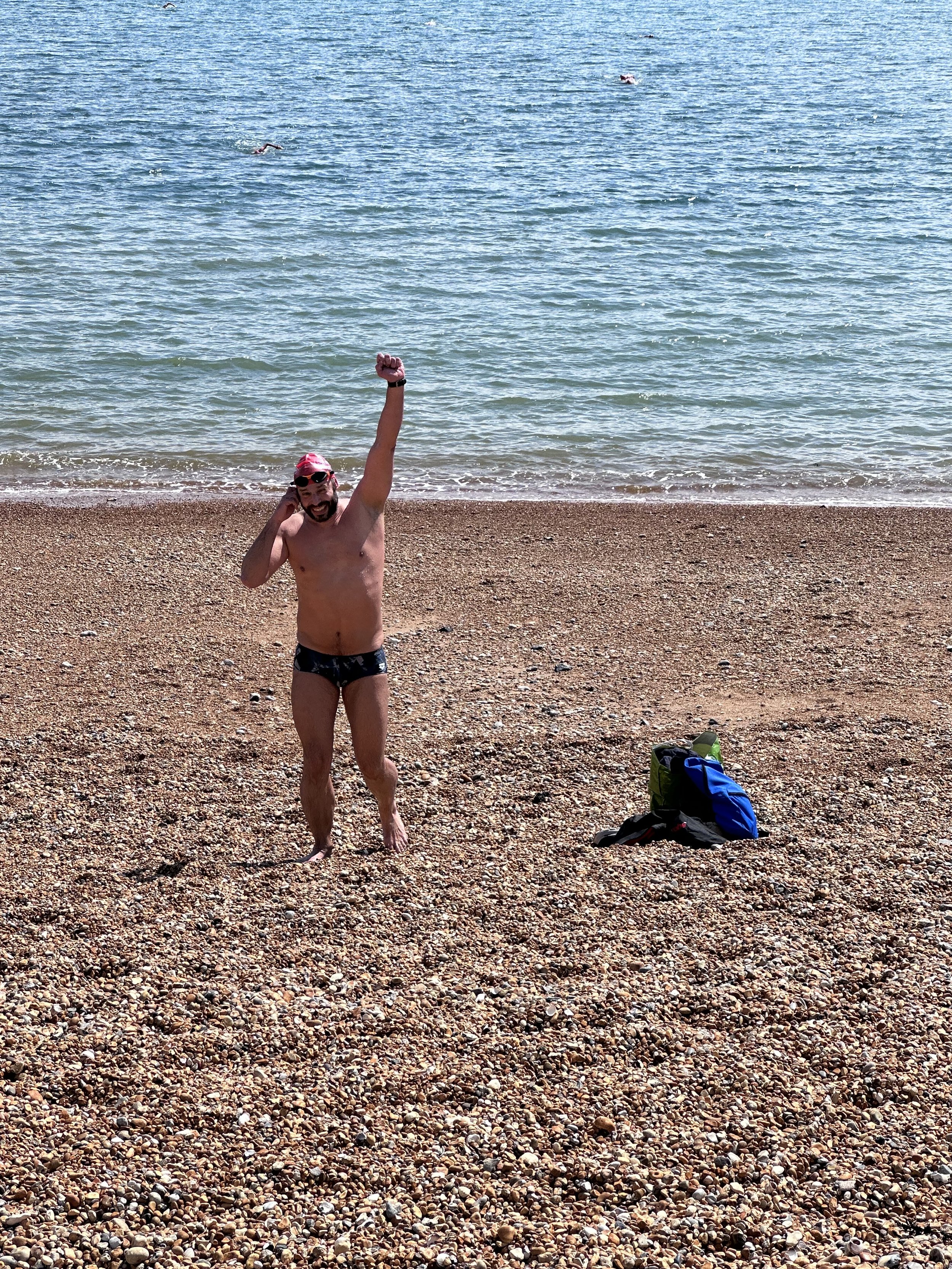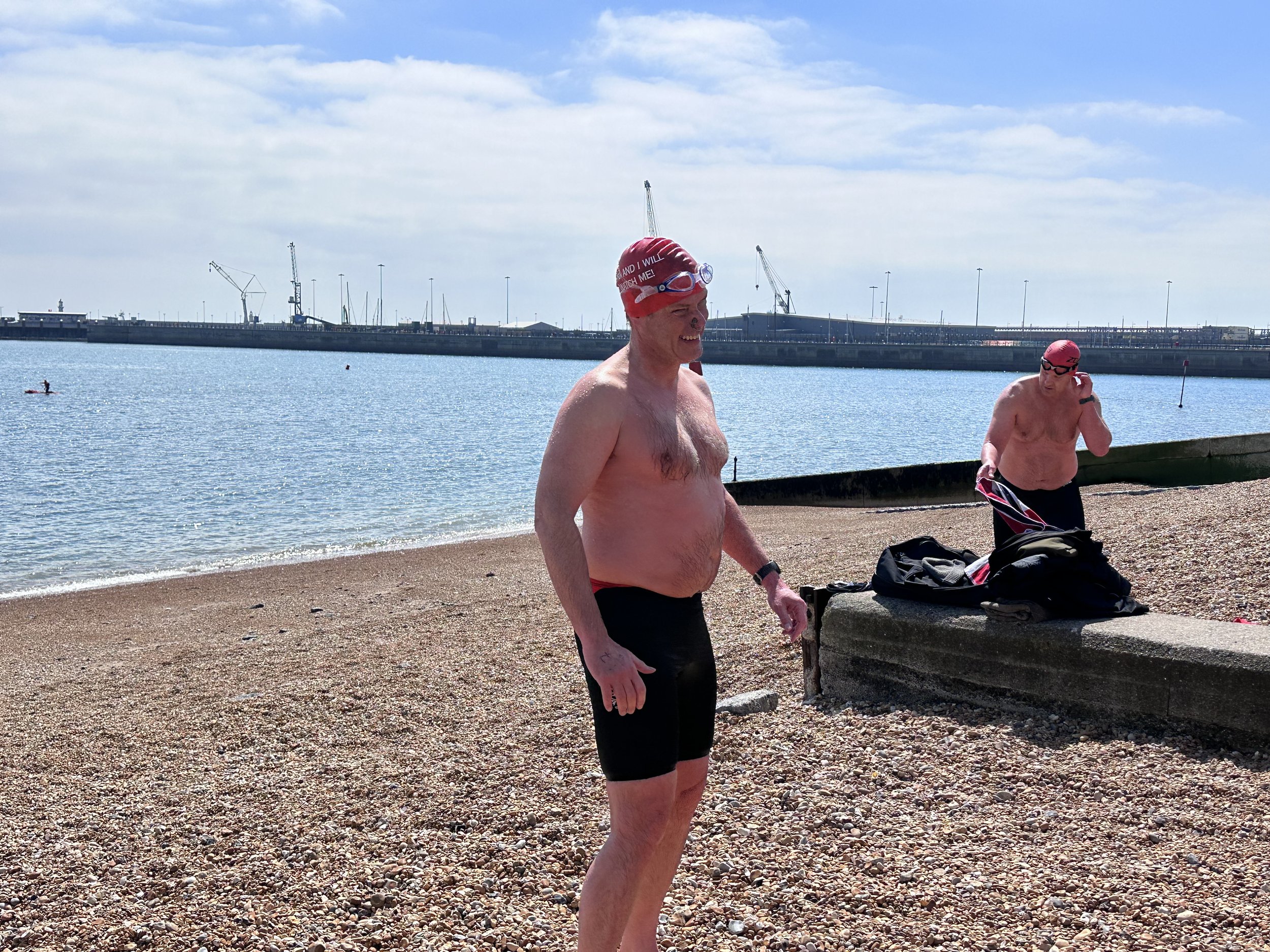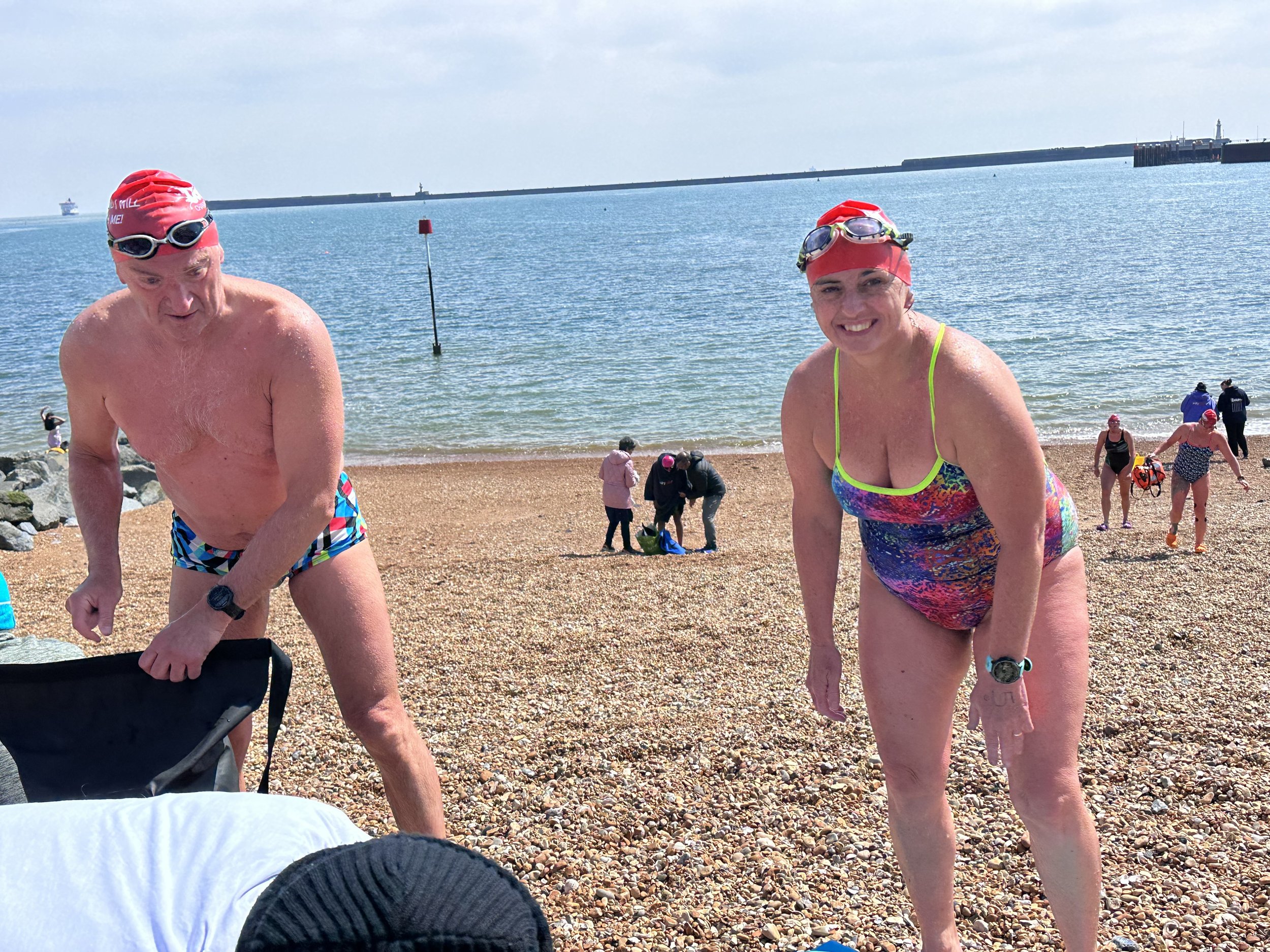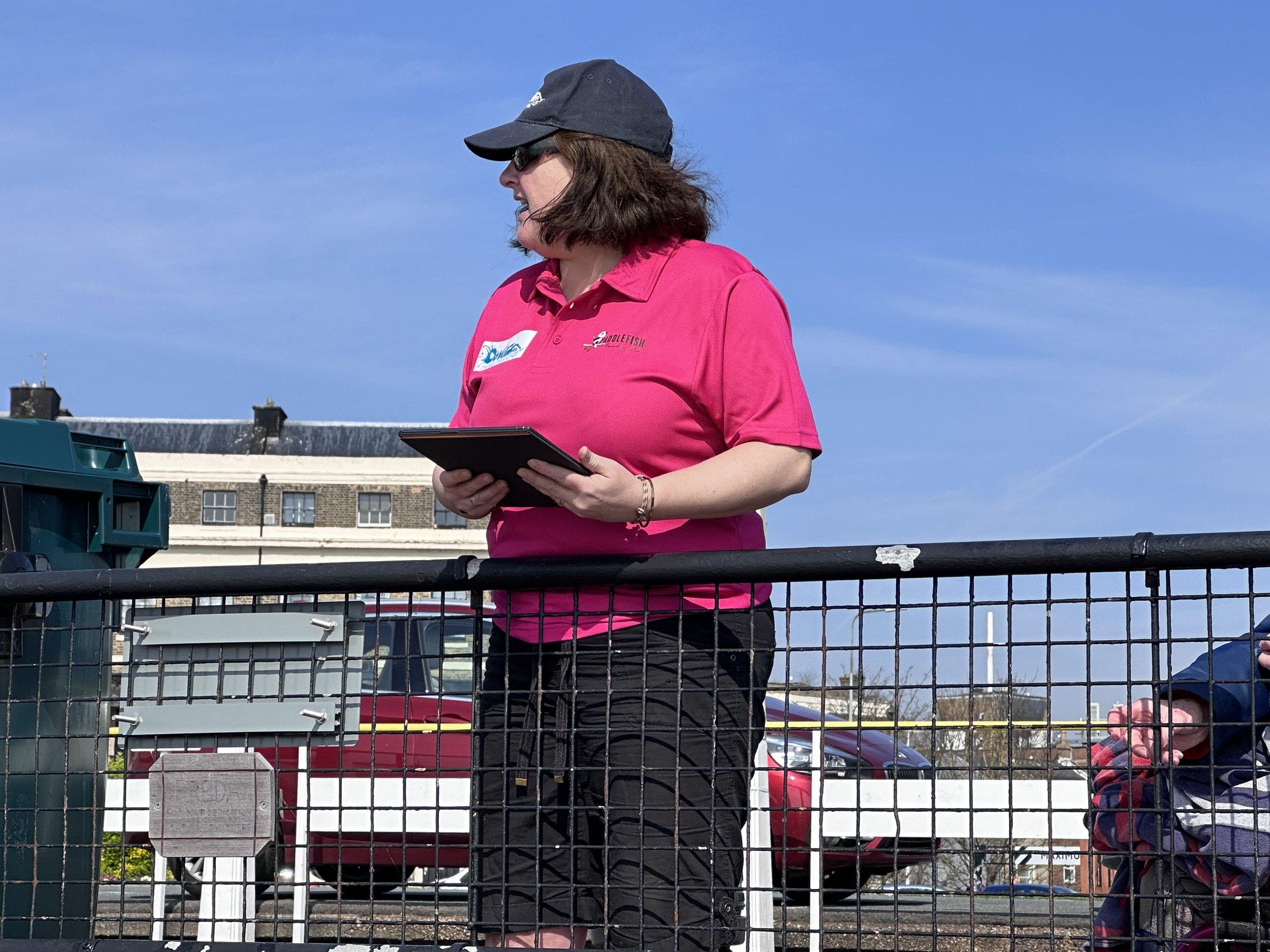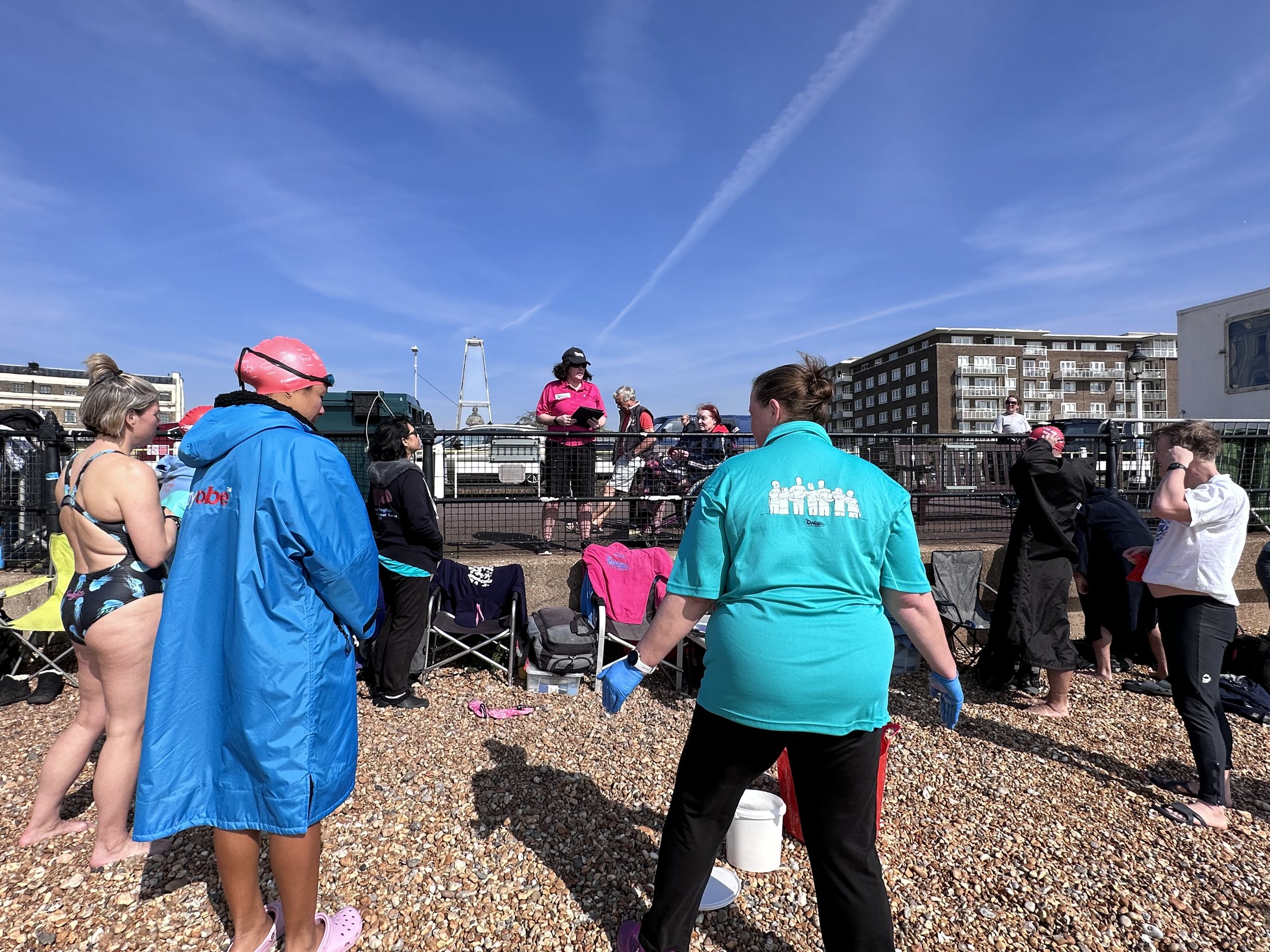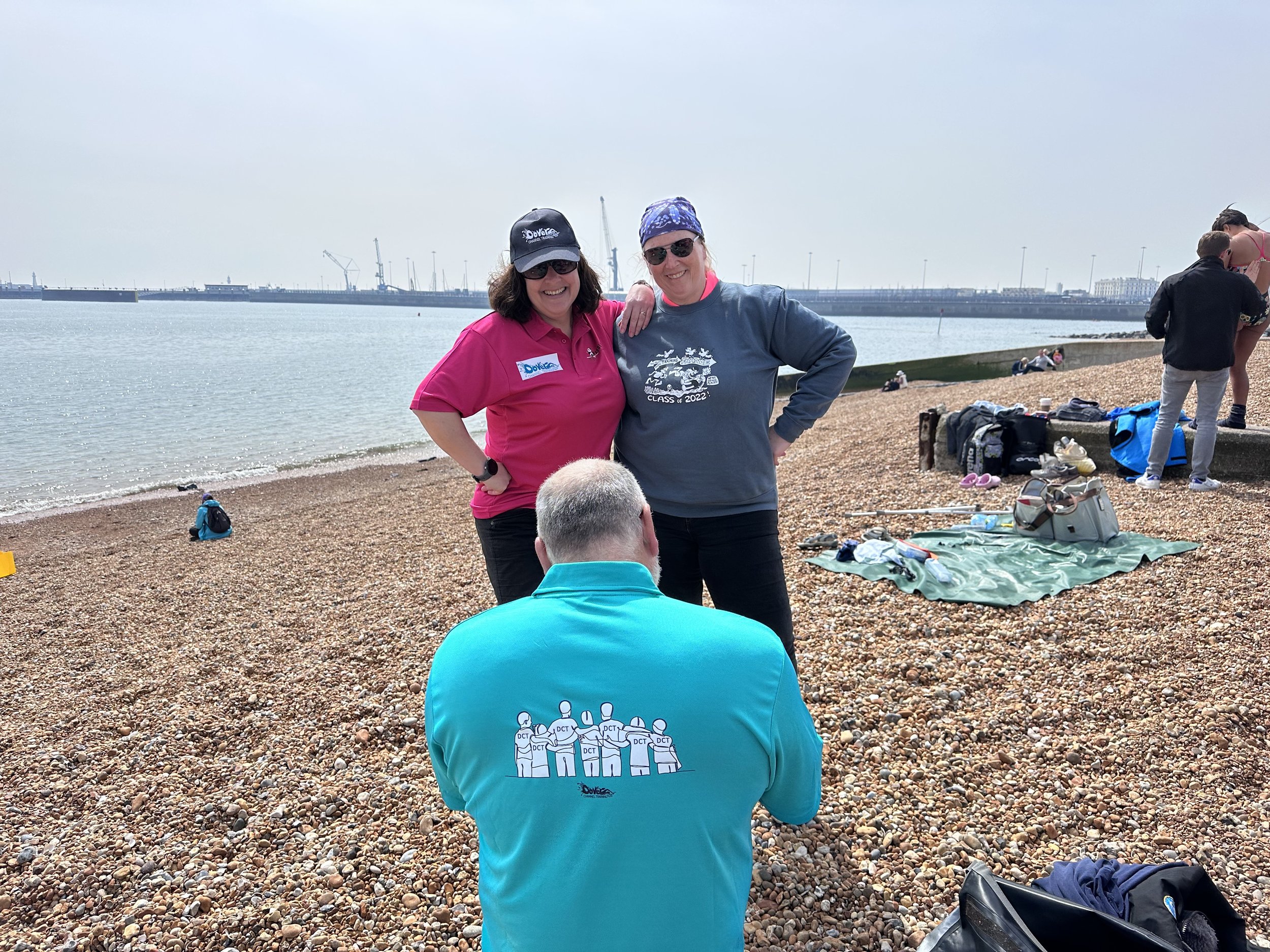Week 1 - Welcome to the Class of 2023
We always start training on the first May Bank Holiday weekend and that normally means starting training in May. Whilst the Bank Holiday was in May, this first weekend was in April which is unusual. Would we have a cold start to the season as a result? Actually no. This weekend was warmer than average and pretty in line with the first week of last year. 😍
Hold on to your (swimming) hats folks, this could be another rapid ramp up for those who need qualifying swims.
5 Steps to training for a Channel Swim
This refers to an English Channel solo. The steps for other swims are the same, what differs is the ‘normal’ volume in step 2
You may have heard me refer to my 5 steps to a channel swim. This refers to an English Channel solo. The steps for other swims are the same, what differs is the ‘normal’ volume in step 2
We’re now on step 4. We will assume that you have done your work in the pool over the winter and have come to training with good technique and an appropriate training habit. If you haven’t, zero to hero is not wise, please build up sensibly to avoid illness & injury.
We’ll now ramp up the cold water swimming and get the qualifying swims done, building in recovery opportunities along the way. It doesn’t stop there though. Step 5 will see different ways for achieving progressive overload.
Progressive overload helps us continuously push our current boundaries. Recovery enables us to cash in on the hard work. Both are equally important.
Continually pushing the boundaries without recovery will lead to signs of overtraining and failing to achieve that oh so important adaptation leading to improved aerobic fitness & capacity. Staying in your comfort zone, only doing ploddy ploddy swimming prevents adaptation and can lead to a decline often noticed in reduced speed.
Let’s work together to hit the sweet spot and maximise your training benefits.
Key information
Before I go into the information from week 1, I wanted to share a few key details about us, how we work, how to get in touch with us and some key processes.
Preparing to train
Your safety is our main priority.
As a reminder, here are some key ways that you can help us to keep you safe:
Arrive on time: Some weekends are very busy indeed and it can take a bit of time to sign you all in. I’ll talk a bit more about volunteer beach crew in a bit, but there’ll generally be one ‘Level 1’ beach crew on the beach who will sign you in and let you know your plan for the day. They’ll have a clipboard or iPad in hand.
Numbered hands: One of our covid adaptations was the introduction of number bands to minimise contact. We are now reverting back to the use of a number on the hand. This number links back to your membership number. This means that if we need to, we can quickly access your contact details, your emergency contact details and any relevant medical information. Once out of the water, please tell the member of the beach crew who has the clipboard or iPad your hand number and we’ll check you out on the system. We’ll check you back in again later for subsequent swims and out again after this second swim. Good news for those who had a tendency to forget to hand in their bands at the end of a session, only to get the delights of Mandi minutes, we do expect you to take your hands home with you, so you’re in the clear!
Safety briefing: at the beginning of each session we’ll share a safety briefing for that session. It will contain any important information that you need to know before entering the water. It is mandatory to attend. We reserve the right to refuse entry to anyone who misses this important briefing. Our static safety briefing for Dover can be found here.
Start time: we enter the water at 10:00 and we ask that everyone is ready to get in promptly. So that means getting your suncream done early, and having vaseline etc done early enough in order to be in the water on time. Feeding for soloists will be on the top of the hour regardless of the time that you got into the water.
Footwear: the pebbles can be difficult to walk on at the best of times. There are also some sharp stones & rock and the possibility of broken glass and other hazards on the beach. We recommend wearing your chosen footwear into the water and taking them off and throwing them back to the beach. We’ll pop them in the trugs whilst you swim and move these trugs up and down with the tide. Give us some time and we’ll learn who’s shoes are who’s and throw them back to you whilst in the water before you finish, again minimising the risk of cuts. The best type of footwear is Croc style and specifically Crocs without holes at the front. Flip flops can be difficult to manage with cold toes. Sliders let stones in.
Personalise your footwear: Normally, at this point in the season we point out that there are a lot of black crocs and that it can be difficult to work out who’s are who’s. Last year Red was the common colour, this year it seems to be camoflage. We seem to have a lot of camoflage style crocs. Please can you ensure that your footwear is easily identifiable as yours so that you can be quickly reunited. Whether that’s with jibitz, ribbons or a sharpie, do something to make yours unique. Well done to those of you who have already done that, it will make life easier for all of us.
Timeliness: when you sign in you agree how long you’re going to be swimming for. If you don’t come back at the time that has been agreed, we start our safety processes and look for you. What we often find is that you’re having a fabulous time and doing much better than you thought, i.e. you know you’re ok. Thing is, we don’t know that. Until we have accounted for you, we are at a heightened state of readiness and we are diverting some of our resources into looking for you. If you are having a great swim, fabulous. Come and tell us and check that it’s ok to continue and we can adjust the plan if appropriate. If you just turn up late, expect us to be grumpy as we will have been looking for a potential casualty.
Swim zone: we are blessed with a large swim zone. Outside of the swim zone other leisure uses also enjoy their sport. Please ensure you stay inside the swim zone. For those of you used to training in lakes, or doing open water races, you may be used to swimming round the outside of buoys. Here’s it’s important to stay inside. There’s no need to swim to the edge as you may find yourself pushed outside of the zone with the tide. On the land side of the zone you need to stay outside of the poles as these mark hazards. The swim zone this year is a lot larger than normal and so I would encourage you to stay well within the buoy markers.
Be prepared: be prepared for when you get out (see warming up below). Pack your bag with the layers that you’ll need first on the top (and make sure that they are the not inside out!). This way when you go to get changed, you have everything that you need to hand. Make sure that your bag is waterproof or placed in a bin bag. Make sure that you pack everything away after you’re changed too. You’d be everso disappointed if your favourite pair of goggles was broken because someone trod on them.
Warm drinks: once dressed, it’s nice to have a warm drink. Some of you brought flasks of drinks with you. That’s a great idea. One of the challenges can be drinking from a small cup when the shivers start. So a cup with a lid will save you wearing more of your drink than you drink!
Talk to us: we are here to help. If you are unsure, ask. Being cold can be a whole new experience to you and knowing what is ‘normal’ cold and when to get out is something you learn over time. We are able to help you with that. We’d much prefer you ask us and help you learn safely than have to help you dress yourself when you are no longer able to do this for yourself.
Warming up
Your process to re-warm starts immediately you leave the water.
For about 30 minutes after you leave the water you will continue to cool down, this is known as the after drop. You may feel absolutely fine when you leave the water and it’s tempting to take off your swim cap (mistake number one) and chat about what an amazing swim you had (mistake number two). Your priority is to ensure that the beach crew know you are out and to get into warm layers (and into your next costume if you have another dip) as quickly as possible.
Use the golden 5 minute window when you get out and before the shivers start to get dressed
Leave your swim hat on until last and until you have a woolly hat to replace it
Wet costume off quickly
When you think about what clothes to wear, lots of loose layers is best (think Sanka from Cool Runnings). Get them on quickly and focus on covering your core first. I personally find that a few merino wool base layers is a great start. Jeans and anything with buttons or zips can be tricky.
As the season progresses you’ll need less. You’ll know when that is he right time for you.
When you are dressed in your layers and have a warm drink, now is the time to compare stories and chat about what a fantastic swim you just had.
Be like Sanka, top marks for anyone who can dress this quickly too!
If you need help, please just ask. Things like zips can be tricky to handle with chilly fingers.
Other aspects of safety
What we do as a sport involves significant physical exertion in sometimes hostile environments, involves the risk of hypothermia and is done with minimal clothing. This can lead to swimmers being vulnerable, at least in a transient way.
Salt water is abrasive and where there is skin on skin or costume on skin contact, chaffing can occur. In order to minimising chaffing we apply vaseline. We appreciate that this can be sensitive and have developed a protocol in order to protect both the swimmer and volunteers. Please familiarise yourself with this.
Your psychological safety is also important to us. Some swimmers have rational or seemingly irrational fears and anxieties when it comes to some aspects of training. There can be a fine line between helping you stretch your comfort zone and what is bullying & harassment. We will never knowingly cause you harm in any physical or mental way and neither will any of our volunteer beach crew. Sport has changed over the years and bullying and harassment has no place in modern sport.
If you have concerns over your situation or that of another swimmer, you can speak to our safeguarding lead in confidence.
About us
Leadership team
Dover Channel Training is a brand that operates within Paddlefish Panda Ltd. It takes a lot of work behind the scenes to make an operation of this size work. To do this we have a Leadership team (which you can read all about here), each with unique responsibilities and background. From time to time we have vacancies within the team and at this time we’re looking to expand our team with a few of new roles:
Marketing & Communications Lead
Website Manager
Retail / Procurement Lead
If you’re interested in joining the team, please contact Emma or another member of the leadership team to find out more.
Volunteer Beach Crew
It’s not just behind the scenes where we have a small army, the same is true on the beach. Over the winter we have reviewed our beach crew structure and brought some new formality to how we operate. You can find out more on our dedicated volunteers page on the website.
We recognise three levels of volunteer beach crew:
Level 1: Overall lead for the session
Level 2: Key support
Level 3: Additional ad-hoc support
We all have differing levels of available time and experience and we believe there is a level for you if you are interested in joining the team.
A bit more information……
Level 1 Volunteers
Our level 1 volunteers run the show on the day. They have the overall responsibility for running a safe training session. These volunteers will plan the day and the duration for each swimmer, they will alter the plan as required and they will operate training in line with our overall principles of training.
These volunteers will have operated at level 2 or 3 in the past are likely to have extensive experience in one or more of the following areas:
Personal experience of solo and / or relay events
Health & safety
Coaching / training others
There will always be at least 1 level 1 volunteer present during a training session. They are likely to be wearing a pink polo shirt (unless there is a special theme!)
Level 2 Volunteers
Our level 2 volunteers support the level 1 volunteers in the practicalities of running the session. They will assist with greasing swimmers, feeding soloists and keeping an eye on all swimmers in the water and on the beach.
Level 2 volunteers are likely to be wearing a turquoise polo shirt (unless there is a special theme).
Level 3 Volunteers
The atmosphere on the beach is second to none and that is because of our vibrant community. Our training environment works so well because we help each other. Our level 3 volunteers are those people who rock up and help on the day. Whether that is forming celebratory arches for swimmers at the end of long swims, or helping out at feeding time, level 3 volunteers are a key part of why DCT has the reputation that it does.
As these volunteers are not planned in advance, there are limitations in what they are able to do as they will not have had the training and induction that our level 1 & 2 volunteers have. As such they will not be asked to act alone, nor will they be involved in aspects such as applying grease to swimmers.
Level 3 volunteers will not have any form of DCT uniform.
If you’re interested in volunteering your time & experience, please get in touch with our volunteers lead.
Training with DCT
We cater for swimmers who want to train with us a little or a lot. The steps that you need to follow are:
Sign the annual disclaimer
Decide your training package
Solo or relay
Pay as you go; block of 10 sessions; season ticket
Book training - this is done from within the membership system (which you log into when you become a member)
Enjoy training with a great group of swimmers
If you have questions, please use one of the contact methods below or get in touch with our membership lead.
Getting support from DCT
We have an extremely large community and a small leadership team. We are here to help you and we need your support to ensure that help is effective. These are the ways in which we are set up to provide support:
Leadership led
On the beach after training
Weekly community call. This runs on a Monday evening from January to September and is hosted by a member of the leadership team. We've set this time aside for you. You can find details of these call within the membership area and within the booking system.
Community led with leadership participation
WhatsApp groups these are now open to all members and you’ll find details of how to join one or more of the groups within the membership area
Social media channels. You’ll find us on Facebook and Twitter.
Given our other professional and family responsibilities, we’re not able to offer individual responses to general enquiries via email, messenger, text etc.
Weekly Review
Note: Water temperature taken during the swim session in the harbour. Air temperature, wind direction & wind speed taken from the Port of Dover app.
Saturday:
Swimmers: 28
Water temperature: 10.5C
Air temperature: 9.8C
Conditions: F3 NNW. Cloudy. Water calm
Sunday:
Swimmers: 14
Water temperature: 11.4C
Air temperature: 10.7C
Conditions: F3 NNW. Sunny. Water calm
Thank you!
Thank you to the following volunteers who were on the rota for the weekend:
Level 1: Emma France; Mandi Bodemeaid
Level 2: Hayley Brant; Halani Foulsham
If you would like to find out more, visit our volunteers page.
I’d also like to say THANK YOU to Pacific Swim Co for their ongoing support and sponsorship of DCT. If you fancy training or doing a special event out in the beautiful San Francisco area, check them out, there are some fantastic training & event options.
Paddlefish Ponderings
We had a great mix of new (to us) and returning swimmers. I sensed anticipation, excitement and a touch of anxiety. This is completely normal. One of the things that I love about the sport is watching people grow in front of my eyes. At the start we often have people a little bit nervous and starting to question their sanity in their chosen plans. Over the weeks as we run the process and you gain experience, that anxiety can give way to confidence and even excitement.
I had a little taste of the whole season during a two week period supporting a couple of SwimQuest training camps in Croatia. In these intense weeks I saw nervousness change to curiosity, to determination, to success. And it’s more than this. I also saw people achieve things that they didn’t know they could. I saw swimmers come to the realisation that they are more capable than they realised.
This is what I love the most.
So, whatever you are currently feeling about your challenge, it’s completely normal! Talk about it. Honesty really is the best policy.
Our plan for the weekend was simply to get to know you, give you a positive first experience and get a view for how you handle cold water. Most swimmers did the same duration in the water, with different targets for relays and soloists and those that are swimming very early or doing a different swim. Well done to Patrick for your two longer swims.
Well done to all swimmers on achieving your targets.
We’ve had a strong start and I sense big things ahead.
As well as the big and obvious achievements, I’m sure there were some personal achievements too. Well done and please do shout about them - you should be rightfully proud of your big and little achievements.
Reminders
Remember to book your sessions online. Bookings close 48 hours ahead. Any bookings after that will need support and that comes with a £5 admin fee.
A few people struggled with booking last week, I’ve since rebuild the appearance of the booking system which should resolve the main issues. Other challenges come down to accessing the membership system. If you continue to experience challenges, please get in touch with us.
Bookings can also be cancelled or rescheduled up to 48 hours ahead. The system doesn’t arrange automatic refunds, so if you would like a refund, please check out our refund policy and get in touch if you would like a refund.
Those of you with training subscriptions, enter your email address and click in the discount code box and your automatic voucher should appear. Let me know if you have any trouble with this.
Please remember to cancel your membership when you no longer want it.
If you are doing an English Channel swim this year please make sure your paperwork is in asap, Tanya who runs the CS&PF office asked that we remind you as there is quite a bit of paperwork outstanding and the deadline has now passed (your qualifying swims can come later). I suspect the same is also true for the CSA.
Keith Oiller is the Swimmer Liaison officer for the CSA and can often be found on the beach during training. If you are a CSA swimmer or are thinking of booking a CSA swim, Keith would be delighted to chat with you.
Looking ahead
Cancelled sessions
Please note that there is no training on Saturday 6th May.
On Tour
Back in 2017, we were forced to train away from Dover on a Saturday due to piling work going on in the harbour. It turned out to be very beneficial with swimmers experiencing a variety of conditions. Dover harbour fantastic as it provides a degree of shelter from the conditions meaning that we can continue training in 99% of conditions. However, it does mean that there are some conditions that you don’t often experience in Dover. In particular long, even swells.
So, once a month we will be On Tour on on Saturday:
Saturday 20th May
Saturday 17th June
Saturday 15th July
Saturday 19th August
Saturday 16th September
The location will either be Hythe or Ramsgate, depending on the weather forecast. Hythe will be our preferred location. The final decision will be made on the Thursday evening before this swim. These sessions are shown as ‘On Tour’ in the booking system.
Night swims
We’re offering two night swim opportunities this season.
Late start on Friday 26th May: this is an opportunity for a short swim (maximum 1 hour) late on a Friday evening. Training on the Saturday remains as normal.
Early start on Saturday 10th June: this is an opportunity for a long swim (maximum of 6 hours) swimming from the dark into daylight
On both of these swims you’ll need to wear two green adventure lights.
As we are not able to assess new swimmers in the dark, we do not accept new (to us) swimmers on these swims. If you want to join us for one of these night swims, you’ll need to join us before as well.
On these swims, during the hours of darkness, we will have additional safety measures in place with a restricted swim zone. This will be explained during the mandatory briefing.
Intensity week
Back by popular demand, we have our mid-season intensity week. If you’re looking for a fun environment to get a solid block of training in, why not come along and join in. We’ll be blending some long swims with some creative ways of training at a variety of intensity levels.
Spotlight in the shop
To bobble or not to bobble? That is the question!
Our beanie hat (exactly the same as the bobble hat but without the bobble), proved extremely popular last year. They are ideal for wearing under the hood of a hoodie or DryRobe. They can also be worn in your car without squashing up against the roof.
Photos
A few photos from the weekend….







